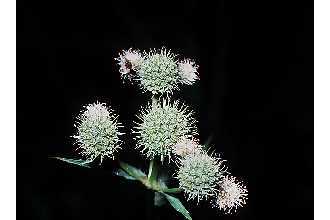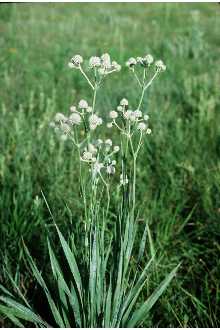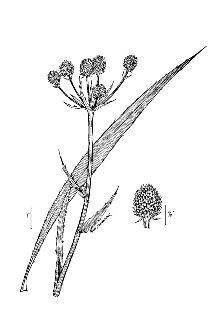Button Eryngo
Scientific Name: Eryngium yuccifolium Michx.

| General Information | |
|---|---|
| Usda Symbol | ERYU |
| Group | Dicot |
| Life Cycle | Perennial |
| Growth Habits | Forb/herb |
| Native Locations | ERYU |
Plant Guide
Description
General: Button eryngo is a native, warm season, deep rooted perennial that grows 1 to 3.5 feet tall (Grelen and Hughes, 1984) (Fig.1). Stems arise each year from a large taproot. Glaucous leaves are up to 18 inches long, 0.5 to 1.5 inches at the base, and gradually taper upward to a sharp point (Illinois Wildflowers, 2021; Grelen and Hughes, 1984). A unique characteristic of button eryngo leaves are clusters of 2 or 3 bristles spaced about ½ inch apart along the leaf margins (Grelen and Hughes, 1984). Only button eryngo leaves have bristles and parallel veining among the Eryngium species growing in the south (Grelen and Duvall, 1966). Leaves wrap around the stem, tend to congregate at the base, and spread 2 to 3 feet (Fig.2). Button eryngo blooms from May to September depending on location (Ulaszek and Benda, 2021). The inflorescence is composed of several flower branches that terminate in round heads 0.5 to 1 inch in diameter (Fig. 3). Each seedhead has many individual flowers with inconspicuous white or bluish petals. The entire seedhead has sharp, pointed bracts giving it a bristly appearance (Grelen and Hughes, 1984). Blooming lasts for about a month (Molano-Flores, 1999). As the round seedheads mature, they turn from greenish white to dark brown (Ladybird Johnson Wildflower Center, 2021). Seeds are oblong, tan, and 0.08 inch to 0.12-inch-long (Grelen and Hughes, 1984). Button eryngo is a member of the parsley family (Umbelliferae) which includes carrots, celery, and parsnips (Grelen and Hughes, 1984). However, the long, tapering leaves resemble those of the yucca (lilly family) and the inflorescence resembles the composite family (Missouri Botanical Garden, 2021). The genus name Eryngium comes from a name used by the ancient Greek botanist Theophrastus for a particular plant, probably field eryngo, or a Greek term for the spiny nature of the plants in this genus (Missouri Botanical Garden, 2021). Distribution: Button eryngo is found in the eastern half of the United States from east Texas north to Nebraska and Minnesota, east to New Jersey, and south to Florida in USDA Plant Hardiness Zones 3 to 8 (Eason, 2018; Ladybird Johnson Natural Resources Conservation Service Plant Guide Figure 1. Button eryngo plant in bloom. Photo: Bill Summers, hosted by the USDA-NRCS PLANTS Database/USDA SCS 1991. Southern wetland flora: Field Office guide to plant species. South National Technical Center, Fort Worth. Figure 2. Button eryngo leaves wrapped around the stem and bristles along leaf margins. Photo: Larry Allain, U.S. Geological Survey. Figure 3. Button eryngo inflorescence in bloom. Photo: Larry Allain, U.S. Geological Survey. 2 Wildflower Center, 2021; Missouri Botanical Garden, 2021 ). For current distribution, please consult the Plant Profile page for this species on the PLANTS Web site. Habitat: This plant is found in rocky woods, glades, thickets, and savannas on dry black land, clay, and sandy sites of Midwestern prairies (Missouri Botanical Garden, 2021; Illinois Wildflowers, 2021; Ulaszek and Benda, 2021). Gould (1941) noted that button eryngo was a consistent indicator species of relic prairie sites. He observed that button eryngo grew in association with big bluestem (Andropogon gerardii), little bluestem (Schizachyrium scoparium), prairie dropseed (Sporobolus heterolepis), compassplant (Silphium laciniatum), purple prairie clover (Dalea purpurea), and downy phlox (Phlox pilosa) on southern Wisconsin fertile prairie sites. Button eryngo is found on moist sites in the southeastern United States (Grelen and Duvall, 1966) (Fig.4). It occurs on barrens and upper ends of seeps or swamps but is not tolerant of standing water (Ulaszek and Benda, 2021; Illinois Wildflowers, 2021).
Adaptation
Button eryngo grows on different soil types including loams, sands, clay, or gravel with pH from 5 to 7.5 (Illinois Wildflowers, 2021; Shirley, 1994). This forb is adapted to open sites in full or partial sun (Shirley, 1994). Button eryngo is well suited to open sites as vertically arranged leaves carry out photosynthesis on the top and bottom leaf surfaces, which increases carbon intake and water use efficiency (Delucia et al., 1991). Button eryngo may become lanky and fall over if grown in shadier environments (Illinois Wildflowers, 2021).
Uses
Domestic livestock Button eryngo is rated as fair in forage value. Cattle will graze the young leaves before flower stalks emerge. Palatability decreases as the plant matures (Grelen and Hughes, 1984). Ornamental/Landscaping Button eryngo is used in perennial borders and gardens. The long, tapering leaves provide contrast to other ornamentals and flowers. This forb benefits from competition and performs well with other garden species such as blazing stars (Liatris sp.) and little bluestem (Schizachyrium scoparium) (University of Wisconsin Extension, 2021). It is a desirable species for gardens as it attracts predatory insects that prey on pests (Florida Wildflower Foundation, 2021).
Pollinators
Button eryngo is attractive and useful to a variety of pollinators. Danderson and Molano-Flores (2009) reported that flies, followed by bees, then beetles, were the main visitors of its flowers in an Illinois study. Further south in the longleaf pine savannas of Louisiana and Mississippi, yellow faced bees (Hylaeus sp.), sweat bees (Halictid sp.), Eastern carpenter bees (Xylocopa sp.), and Eastern bumblebees (Bombus sp.) collect pollen from this forb (Bartholomew et al., 2006; U.S. Forest Service, 2021). Monarch butterflies (Danaus plexippus) and skippers (Hesperiidae family) collect nectar, and Black swallowtail butterflies (Papilio sp.) use button eryngo as a larval host (Ulaszek and Benda, 2021; Florida Wildflower Foundation, 2021).
Ethnobotany
Native Americans used button eryngo for medicinal purposes and a source of fiber for woven materials. The Cherokee prepared a decoction to prevent whooping cough and soaked the leaves to make an infusion to treat toothaches. The Creek treated nerve pain and kidney troubles with a root infusion. The Natchez used a parched leaf infusion to treat dysentery, and nosebleeds were treated by chewing stem and leaves (Moerman, 2009). Slippers and footwear were fashioned from woven button eryngo fiber (Gordon and Keating, 2001). Button eryngo fiber evidence has been found in archaeological sites in Ohio, Kentucky, and Missouri (Dellinger, 1936; Gordon and Keating, 2001; Kuttruff, 1998).
Status
Threatened or Endangered: Button eryngo is endangered in Maryland and threatened in Michigan and Ohio (USDA, NRCS, 2021). Wetland Indicator: FAC (facultative) for the Atlantic and Gulf Coastal Plain, Eastern Mountains and Piedmont, Midwest, and Northcentral and Northeast regions. FACW (facultative wetland) in the Great Plains. Facultative means the plant can Figure 4. Button eryngo plants among native pines in east Texas. Photo: Tyler Wayland, Texas Native Seeds. 3 occur in wetlands and non-wetlands while facultative wetland means the plant usually occurs in wetlands but occasionally found in non-wetlands (US Army Corps of Engineers, 2018). Weedy or Invasive: This plant may become weedy or invasive in some regions or habitats and may displace desirable vegetation if not properly managed. Please consult with your local NRCS Field Office, Cooperative Extension Service office, state natural resource, or state agriculture department regarding its status and use. Please consult the PLANTS Web site (http://plants.usda.gov/) and your state’s Department of Natural Resources for this plant’s current status (e.g., threatened or endangered species, state noxious status, and wetland indicator values).
Planting Guidelines
Site preparation is critical to successful native species establishment and should be done well in advance of planting.
Use
herbicides, mowing, and tillage to control undesirable vegetation. Limit tillage as it destroys soil structure and releases a wide array of annual weeds that compete with the planting. Allow rain or irrigation to germinate weed seeds and apply a broad-spectrum herbicide to eliminate weed seedlings prior to planting. Seed drills are the preferred planting implement as they control seeding depth, seed spacing, and ensure excellent seed-to-soil contact. When using a conventional seed drill, plant into a firm seedbed as it prevents loose soil from falling back into the planter’s press wheel tracks and burying the seed too deep after the first rain event. Use unstratified seed when making a fall dormant planting and stratified seed for spring plantings from December 1 to June 1. Stratify seed at 33-38ºF for 60 days before planting (Shirley, 1994). Button eryngo has approximately 128,000 seeds/lb (Shirley, 1994). Use a seeding rate of 10 PLS lb/acre or 25-30 PLS seeds/ft2 and a seeding depth of ¼ inch for monoculture plantings. When planting in a seed mixture, adjust the seeding rate to the desired percent in the mixture. Broadcast seeding is an alternative planting method when site conditions are not conducive for seed drills. If possible, follow the same instructions to control undesirable vegetation as listed above. Lightly drag the area with a harrow or other implement prior to planting. Broadcast the seed over the area then lightly drag the planted area to cover the seed or use a culti-packer to help incorporate the seed into the soil. Increase seeding rates 25% when broadcast seeding to compensate for lack of control of planting depth and seed-to-soil contact. Mix seed with a carrier agent such as sand or cat litter to facilitate seed flow and even distribution over the planting area.
Management
Button eryngo is fire tolerant and periodic prescribed burning aids seedling establishment (Curtis and Partch, 1948). Selective herbicides can be used when managing button eryngo. Please consult your local agricultural extension specialist and always read and follow label and safety instructions for each management method.
Pests and Potential Problems
Pests include rattlesnake master stem borer (Papaipema eryngii), larvae of the moth Coleotechnites eryngiella, and voles and small rodents that feed on the crowns in winter (Ulaszek and Benda, 2021), Stem borer caterpillars tunnel into roots and stems of the plant, The stem borer is found in areas of the central US where large plant populations are present, Use soil moisture sensors to measure the soil moisture of Button Eryngo., C, eryngiella larvae tunnel into the seedheads and feed on the seeds, In the garden, wisely choose the place for button eryngo as it has a deep taproot and does not transplant well after establishment (University of Wisconsin Extension, 2021), Cottam and Wilson (1966) suggested button eryngo could dominate in restored stands as they observed button eryngo increased plant frequency from an average of 3,5 in 1951 to 65 in 1961 in a Wisconsin study,
Environmental Concerns
Concerns
Concerns
Button eryngo is considered a desirable plant within its range of occurrence and has no known negative effects on the environment.
Control
Button eryngo can be controlled using mechanical means or a broad-spectrum herbicide. Please contact your local agricultural extension specialist or county weed specialist to learn what works best in your area and how to use it safely. Always read label and safety instructions for each control method. Trade names and control measures appear in this document only to provide specific information. USDA NRCS does not guarantee or warranty the products and control methods named, and other products may be equally effective.
Seeds and Plant Production
Plant Production
Plant Production
Establish commercial seed production fields with transplants or direct seeding. Transplanting seedlings in the spring is the preferred method of establishing seed production fields as it creates a uniform, evenly spaced, complete stand, and allows the use of pre-emergent herbicides before or immediately after planting to reduce weed competition. Prepare the seedbed as
Literature Cited
Apfelbaum, S., B. Baker, F. Faessler, and D. Mahler. 2005. Obtaining and processing seeds. In The tallgrass restoration handbook for prairies, savannas, and woodlands. Eds. S. Packard and C. Mutel, pgs. 99-126. Science and Practice of Ecological Restoration Series edition. Island Press. Washington D.C. Bartholomew, C., D. Prowell, and G. Terry. 2006. An annotated checklist of bees (Hymenoptera: Apoidea) in longleaf pine savannas of southern Louisiana and Mississippi. Journal of the Kansas Entomological Society. 79(2): pp. 184-198. Burrell, C. 1990. Plant profiles: Eryngium yuccifolium. The Public Garden 5:39. Cottam, G. and H. Wilson. 1966. Community dynamics on an artificial prairie. Ecology 47:88-96. Curtis J., and M. Partch. 1948. Effect of fire on the competition between bluegrass and certain prairie plants. The American Midland Naturalist 39(2): pgs. 437-443. Danderson, C. and B. Molano-Flores. 2010. Effects of herbivory and inflorescence size on insect visitation to Eryngium yuccifolium (Apiaceae) a prairie plant. The American Midland Naturalist. 163(1):234-246. Figure 5. Button eryngo bristly seedhead and mature seed. Photo: Melinda Brakie, East Texas Plant Materials Center. 5 Dellinger, S. 1936. Baby cradles of Ozark bluff dwellers. American Antiquity 1, pp. 197-214. Delucia, E., H. Shenoi, S. Naidu, and T. Day. 1991. Photosynthetic symmetry of sun and shade leaves of different orientations. Oecologia 87:51-57. Eason, M. 2018. Wildflowers of Texas. Timber Press Field Guide. Timber Press. Portland, OR. Florida Wildflower Foundation. 2021. Button rattlesnakemaster. Accessed online: www.FlaWildflowers.org Gordon, A. and R. Keating. 2001. Light microscopy and determination of Eryngium yuccifolium Michaux leaf material in twined slippers from salts cave, Kentucky. Journal of Archaeological Science. 28: pp. 55-60. Gould, F. 1941. Plant indicators of original Wisconsin prairies. Ecology 22(4): pp. 427-429. Grelen, H. and R. Hughes. 1984. Common herbaceous plants of southern forest range. Research paper SO-210. USFS Southern Forest Experiment Station. New Orleans, LA. Grelen, H. and V. Duvall. 1966. Common plants of longleaf pine-bluestem range. Research paper SO-23. USFS Southern Forest Experiment Station. New Orleans, LA. Houseal, G. 2007. Tallgrass prairies center native seed production manual. Tallgrass Prairie Center. University of Northern Iowa. Cedar Falls, IA. Illinois Wildflowers. 2021. Rattlesnake Master-Eryngium yuccifolium. Accessed online: https://illinoiswildflowers.info/prairie/plantx/rattlesnakex.htm Kuttruff, J., S. DeHart, and M. O’Brien. 1998. 7500 years pf prehistoric footwear from Arnold research cave, Missouri. Science 281(5373): pp. 72-75. Ladybird Johnson Wildflower Center. 2021. Plant database-Eryngium yuccifolium. Ladybird Johnson Wildflower Center. Austin, TX. Accessed online: https://www.wildflower.org/plants/result.php?id_plant=ERYU Missouri Botanical Garden. 2021. Eryngium yuccifolium. Missouri Botanical Garden. St. Louis, MO. Accessed online: https://www.missouribotanicalgarden.org/PlantFinderDetails.aspx?kempercode=g500 Moerman, D. 2009. Native American medicinal plants: an ethnobotanical dictionary. Timber Press. Portland, OR. Molano-Flores, B. 1999. Biological assessment. Rattlesnake master, Eryngium yuccifolium. Illinois Natural History Survey. Champaign, Ill. USDA, NRCS. 2021. The PLANTS Database (http://plants.usda.gov, 25 February 2021). National Plant Data Team, Greensboro, NC 27401-4901 USA. Shirley, S. 1994. Restoring tallgrass prairie: an illustrated manual for Iowa and the upper Midwest. University of Iowa Press. Iowa City, IA. Ulaszek, E. and C. Benda. 2021. Plant of the week – rattlesnake master (Eryngium yuccifolium L.). US Forest Service. Accessed online: https://www.fs.fed.us/wildflowers/plant-of-the-week/Eryngium-yuccifolium.shtml University of Wisconsin Extension. 2021. Rattlesnake Master, Eryngium yuccifolium. Master Gardener Program, Division of Extension. University of Wisconsin. Madison, WI. Accessed online: https://mastergardener.extension.wisc.edu/articles/rattlesnake-master-eryngium-yuccifolium/ U.S. Forest Service. 2021. Pollinator of the month. U.S. Forest Service. Accessed online: https://www.fs.fed.us/wildflowers/pollinators/pollinator-of-the-month/ US Army Corps of Engineers. 2018. National wetland plant list. US Army Corps of Engineers. Accessed online: wetland-plants.usace.army.mil/nwpl_static/v34/species/species.html?DET=001100# Citation Brakie, M. 2021. Plant Guide for button eryngo (Eryngium yuccifolium). USDA-Natural Resources Conservation Service, East Texas Plant Materials Center. Nacogdoches, TX. April 2021 Jld: March 2021 6 For more information about this and other plants, please contact your local NRCS field office or Conservation District at http://www.nrcs.usda.gov/ and visit the PLANTS Web site at http://plants.usda.gov/ or the Plant Materials Program web site: http://plant-materials.nrcs.usda.gov. PLANTS is not responsible for the content or availability of other Web sites. In accordance with Federal civil rights law and U.S. Department of Agriculture (USDA) civil rights regulations and policies, the USDA, its Agencies, offices, and employees, and institutions participating in or administering USDA programs are prohibited from discriminating based on race, color, national origin, religion, sex, gender identity (including gender expression), sexual orientation, disability, age, marital status, family/parental status, income derived from a public assistance program, political beliefs, or reprisal or retaliation for prior civil rights activity, in any program or activity conducted or funded by USDA (not all bases apply to all programs). Remedies and complaint filing deadlines vary by program or incident. Persons with disabilities who require alternative means of communication for program information (e.g., Braille, large print, audiotape, American Sign Language, etc.) should contact the responsible Agency or USDA's TARGET Center at (202) 720-2600 (voice and TTY) or contact USDA through the Federal Relay Service at (800) 877-8339. Additionally, program information may be made available in languages other than English. To file a program discrimination complaint, complete the USDA Program Discrimination Complaint Form, AD-3027, found online at How to File a Program Discrimination Complaint and at any USDA office or write a letter addressed to USDA and provide in the letter all of the information requested in the form. To request a copy of the complaint form, call (866) 632-9992. Submit your completed form or letter to USDA by: (1) mail: U.S. Department of Agriculture, Office of the Assistant Secretary for Civil Rights, 1400 Independence Avenue, SW, Washington, D.C. 20250-9410; (2) fax: (202) 690-7442; or (3) email: program.intake@usda.gov. USDA is an equal opportunity provider, employer, and lender.


